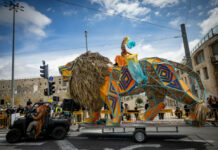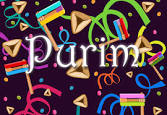
For the Jewish month of Adar, the Talmud encourages Jewish people to greet the month with an increase of joy and celebration, culminating with the celebration of Purim, this year on March 6-7.
While many Jews may celebrate the auspicious month with mishloach manot and hamantaschen, Philadelphia rabbis and cantors are hard at work with last-minute additions to their Purimspiel scripts and costumes. Ahead of the holiday — commemorating the resilience of the Jewish people, led by Mordechai and Esther against the oppressive Haman — a few clergy members shared their thoughts on what makes a Purimspiel meaningful.
Pick a memorable theme
“Every year, people ask me, ‘What’s the theme going to be?’ And I always say, ‘Well, the theme is going to be Purim,’” joked Cantor Jessi Roemer of Society Hill Synagogue.
In truth, Roemer picks a different musical inspiration annually to set the music for the Purimspiel. This year, Society Hill Synagogue is presenting “Nothing Compares: A Purple Persian Pan-Gen Explosion” parodying the songs of Prince.
Roemer tries to pick musical inspiration that spans across generations. Though writing parody is challenging and is “the most derivative form of songwriting,” it also means that a good chunk of the congregation will already know the tunes.
“It’s an easy way to get everybody in the room to sing along,” she said.
If picking an artist or album to parody, be sure to remember that the congregants singing along, though enthusiastic, may be unable to match the vocal prowess of, say, Mariah Carey or Celine Dion.
Know your audience
Congregations are diverse communities, and kids and adults have different attention spans and interests. As a result, some synagogues plan to hold different spiels for the two groups.
At Congregation Rodeph Shalom, Cantor Bradley Hyman has two Purimspiel offerings: A “Sesame Street”-themed play for children and an Elton John spiel for adults. In addition to differences in music and the length of the productions, the two shows will also tell the Purim story differently, accounting for the dark themes and violence present in the original story — such as Ahashverosh’s sexual exploitation of Vashti — that may not be appropriate for children.
“Something, for example, that’s designated for children and families should be shorter, should have a lot of accessible music or music parody, but effectively tells that story of Esther without skipping the main messages, which should be bravery, self respect and survival,” Hyman said.
Adult spiels can focus on the broader themes of the Purim story, according to Hyman, but should look past the seriousness of them and, like a children’s spiel, should focus on values of resilience, survival and celebration.
“If you can do all of that, and still laugh at yourself, then maybe it’s good,” he said.
Involve the community
Though a cantor or rabbi is often in charge of writing a spiel’s lyrics and scripts, the performance is often a community affair. At Society Hill, about 50 people are involved in the production, according to Roemer. At Rodeph Shalom, 40 are involved.
With congregant participation, Purimspiels take on a life of their own. At Temple Beth Zion-Beth Israel, in addition to the traditional spiel, congregants create a video twice annually about a Jewish village with the same cast of characters for the past 10 years. Over the decade, interest in the project has grown, with more members of the village being added.
The synagogue staff also creates a spiel with inside jokes about BZBI’s culture, such as the tendency for the bar or bat mitzvah kid to leave their bag of gifts, created by the synagogue’s Sisterhood, at the shul. The jokes, though specific, should never target an individual or be mean-spirited.
“You want everyone to be in on the joke,” Rabbi Abe Friedman said.
Remember the Purim story
At the end of the day, Purim is a story of Jewish history, and spiels are an opportunity for learning. But Jews have long balanced joy and sorrow, which Rabbi Eric Yanoff of Adath Israel on the Main Line believes is the key to finding meaning in the holiday.
“One of the ways that people respond to such turns of fate is through laughter and satire and irony and other forms of humor, and Jews have really embraced that throughout our history,” Yanoff said.
Humor can offer catharsis and a way to process difficult themes. Purimspiels, with a different theme every year, also let congregations use a Jewish story to connect with the issues of the day in a more accessible way.
“The story is not a one-time flash in the pan in history,” Yanoff said. “But rather, it becomes generalized to other moments.”






